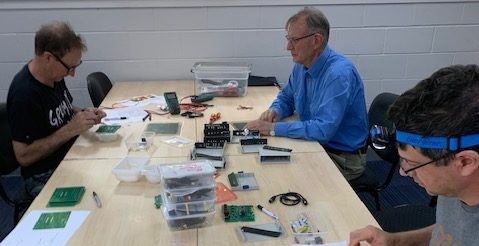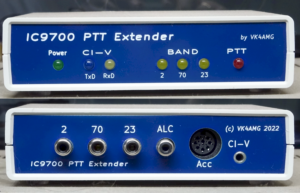Tropospheric conditions are used mostly with VHF/UHF/SHF side of our hobby. Below are listed several types of tropospheric propagation.
VK3FS has also provided some interesting reading Here :
There are several types of tropospheric propagation according to meteorologists:
Radiation Tropo
Radiation Tropo is also known as Radiative Cooling Tropo or Nocturnal Tropo. A common nocturnal event that often occurs during clear, calm nights on land. Radiative cooling results in cooler more humid conditions near the surface which forms a shallow inversion. This inversion usually “burns off” shortly after sunrise. Due to its shallow nature, Radiation Tropo often follows the topography of the land.
High Pressure Tropo
Also known as Subsidence Tropo. Sinking air (subsidence) in a high-pressure system warms and dries as it descends. Often cool moist air can become trapped underneath forming an inversion. High-Pressure tropo can last all day. Often, Radiation Tropo occurs simultaneously at night, blocking more distant signals from High-Pressure Tropo. As a result, conditions can often be better during the day.
Frontal Tropo
Frontal inversions can be found in the area ahead of an approaching warm front, behind a departing cold front, or north of a quasi-stationary front. Inclement weather often accompanies fronts and may hinder duct formation. Due to the normally fast motion of cold fronts, cold frontal tropo events are often short-lived.
Advection Tropo
Advection Tropo comes in two forms. Warm Air Advection Tropo occurs when warm dry air overrides cooler moist land (example: recently rain-soaked land) resulting in a shallow inversion. Cold Air Advection Tropo occurs when cool moist air undercuts warmer drier air aloft. This can often occur along the northern and western flanks of tropical cyclones as they advance into the temperate zones.
Downslope Tropo
Also known as Chinook Tropo, Santa Ana Tropo, Fœhn Tropo, Bora Tropo, Zonda Tropo, etc. Downslope Tropo is caused by air descending down a mountainside that warms and dries as it descends. If the pre-existing airmass is cool enough, it may become trapped under an inversion.
Valley Tropo
Warm dry air can override cooler moist air trapped in a valley under the resulting inversion. This is different from topography-conforming Radiation Tropo in that the inversion can persist all day long, long after any radiative effects have dissipated.
Marine Tropo
Also known as Maritime Tropo, Oceanic Tropo or Lake-Effect Tropo. Marine Tropo occurs when warm dry air overrides a cooler body of water. Marine inversions often extend the entire breadth of lakes and can extend for thousands of kilometres over the ocean. It also spreads into coastal areas by way of sea or lake breezes. Marine tropo can become enhanced or combined with other types such as High-Pressure Tropo. It normally peaks during the afternoon when the inversion is the strongest. Outside of the equatorial zone, spring and early summer is the best season.
A basic principle of radio is that the wavelength of a signal gets shorter as the frequency of the signal is increased. Because of this, the size of the tropospheric duct determines the lowest signal frequency that it can successfully propagate. This is known as the Lowest Usable Frequency or LUF of the duct.
A physically small duct, a duct with its upper and lower boundaries close together, will propagate only higher frequency signals with very short wavelengths. As the distance between the boundaries of the duct increases, the signal frequency the duct will propagate decreases. In other words, a larger duct will accommodate a lower frequency signal having a physically longer wavelength. It’s possible for a duct to form that only supports signal propagation at UHF, while not effectively passing anything in the VHF bands.
Ducted signals from 1400 – 1600 km are fairly common, but it’s more common for ducted signals to travel 800 – 1300km. Ducted signals are typically quite strong, sometimes so strong that they can cause interference to local signals on the same
frequency.
A basic principle of radio is that the wavelength of a signal gets shorter as the frequency of the signal is increased. Because of this, the size of the tropospheric duct determines the lowest signal frequency that it can successfully propagate. This is known as the Lowest Usable Frequency or LUF of the duct.
A physically small duct, a duct with its upper and lower boundaries close together, will propagate only higher frequency signals with very short wavelengths. As the distance between the boundaries of the duct increases, the signal frequency the duct will propagate decreases. In other words, a larger duct will accommodate a lower frequency signal having a physically longer wavelength. It’s possible for a duct to form that only supports signal propagation at UHF, while not effectively passing anything in the VHF bands.
Ducted signals from 1400 – 1600 km are fairly common, but it’s more common for ducted signals to travel 800 – 1300km. Ducted signals are typically quite strong, sometimes so strong that they can cause interference to local signals on the same
frequency.
Weather Suitable for a Duct – Tropospheric ducting most often occurs because of a dramatic increase in temperature at higher altitudes. If the temperature inversion layer has lower humidity than the air below or above it, the refractive index of the layer will be enhanced further. There are several common weather conditions that often bring about strong temperature inversions.
While not usually the cause of strong ducting, radiation inversions can bring about pronounced signal enhancement, extending the DX range up to a few hundred kilometres. This is probably the most common and widespread form of inversion a DXer is likely to encounter on a regular basis.
A radiation inversion forms over land after sunset. The Earth cools by radiating heat into space. This is a progressive process where the radiation of surface heat upwards causes further cooling at the Earth’s surface as cooler air moves in to replace the upward moving warm air. At higher altitudes the air tends to cool more slowly, thus setting up the inversion. This process often continues all the way through the night until dawn, sometimes producing inversion layers at 1,000 to 2,000 feet above the ground. Radiation inversions are most common during the summer months on clear, calm nights.
The effect is diminished by blowing winds, cloud cover and wet ground. Radiation inversions are often more pronounced in dry climates, in valleys and over large expanses of flat, open ground.
| Virus-free.www.avg.com |

